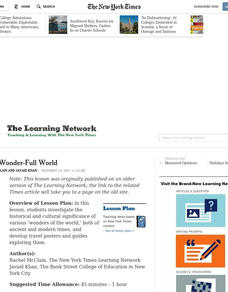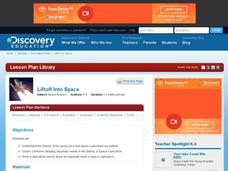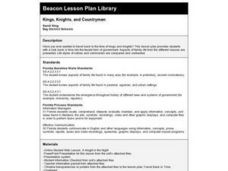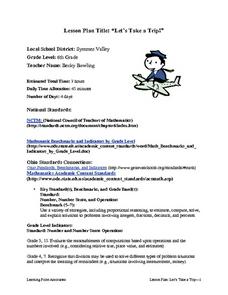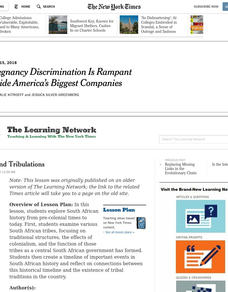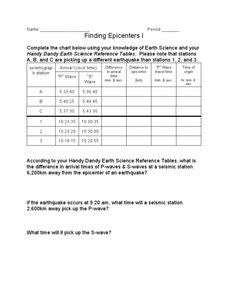Curated OER
What a Wonder-Full World
Students investigate the historical and cultural significance of various 'wonders of the world,' both of ancient and modern times, and develop travel posters and guides exploring them.
Curated OER
Magnetic Forces and Kinetic Energy
In this magnetic forces and kinetic energy worksheet, students use the formula that relates the speed of an electron in a plasma cloud to its energy to find the speed of 6 different plasma cloud electrons. They answer 5 questions that...
Curated OER
A Classical & Relativistic Trip to a Black Hole
Students calculate distance, velocity, acceleration and time on their fantasy trip to the black hold. They apply Newton's Laws of Motion and calculate circular motion. They discuss any questions that may arise.
Curated OER
Liftoff Into Space
Learners explore the history of space exploration. In this history of space exploration lesson, students create a timeline of space exploration. Learners watch a space video and discuss important events. Students research space...
Curated OER
Projectile Motion
Students observe projectile motion and calculate the speed of a baseball based on the time and distance traveled. They record the time, measure the distance, and draw the path of the ball's travel on a data table.
Curated OER
Grade 1: More Land or Water?
First graders listen as the teacher reads a story involving cross-continent traveling. Students collect a random sample by tossing an inflatable globe and recording whether they touch land or water each time they catch the globe in order...
Curated OER
Which Way Did He Go?
In this visual thinking activity, 5th graders determine which of three routes that Max should take to get to a party by noon. Students answer 10 fill in the blank questions relating to different amounts of time and miles.
Curated OER
Kings, Knights, And Countrymen
Students look back in time into the feudal form of government. They view Powerpoint presentations to take them back in time.
Curated OER
Deep Thoughts
Students examine what lies within the Earth. They research and create scale models illustrating the layers of the Earth and write skits advocating a travel plan to send a probe into the Earth's mantle.
Curated OER
Discoveries of Titanic Proportions
Young scholars analyze various statements on the moon. After reading an article, they discuss the findings about a new moon around Saturn. In groups, they re-create a press conference in which the new findings were released to the...
Curated OER
Let's Go To Mexico
Learners are able to use the Internet to conduct research. They research Mexican culture and traditions. Students compare and contrast Mexican and U.S. food and clothing. They convert United States currency to Mexican pesos. Learners...
Curated OER
All The Way to Timbuktu
Students discuss the concept of historic preservation and relate it to their own families and communities. After reading an article, they discuss the efforts of Mali to preserve their history. Using the internet, they research one...
Curated OER
Westward Expansion
Students explore the Westward Expansion Movement of U.S. history. In this Westward movement lesson, students use primary and secondary source documents research personal accounts of those who travelled west during the era....
Curated OER
Gravity, Angles, and Measurement
Students relate math to real life scenarios. In this geometry lesson, students launch a ball tracking each launch using a graph. They analyze their data for speed, angles and distance, trying to improve on each launch.
Silos & Smokestacks National Heritage Area
Life as a Pioneer
Students examine historical documents and research why early pioneers settled on the Iowa prairie. They review maps, describe the impact of railroading, describe life in pioneer times, and identify the effects of drought, prairie fire,...
Curated OER
A Little Horse Sense
How have horses evolved over time? How do horse skulls reveal this evolution? How have the roles horses play changed over time? What kind of social structure do horse herds have? How should wild horse populations be managed? To find the...
Curated OER
Sound
Young scholars identify sources and importance of sound, discuss sounds heard on way to school, explain why sound waves can be "seen", and participate in various classroom activities and experiments that illustrate how sound travels.
Curated OER
Let's Take a Trip!
Sixth graders plan a trip for a family of four choosing their travel plan by studying maps to decide upon a route and visiting Websites to get airline and travel schedules. They use ratios and proportions as well as converting fractions...
Curated OER
Rectilinear Motion
Twelfth graders rewrite word problems using algebraic expressions. In this calculus lesson plan, 12th graders calculate the velocity, time and acceleration while analyzing real life scenarios. They solve problems related to when the...
Curated OER
Tribes And Tribulations
Students explore South African history from pre-colonial times to today. They create a timeline of important events in South African history and reflect on connections between this timeline and the existence of tribal traditions in the...
Curated OER
Wave Superposition: Interactive On-line Mac and PC
Students study definitions of wavelength, wave speed, wave amplitude, and wave period using an interactive JAVA environment. Distance and time are given so speed=wavelength/period can be verified or deduced by students. Waves reflection...
Curated OER
Finding Epicenters 1
In this finding epicenters worksheet, students complete a table given the "P" and "S" wave arrival times of 6 different earthquakes. Students calculate the difference in arrival time of the waves, the distance to the epicenter, the "P"...
Curated OER
Natural Inspiration
Students relate math to the real world. In this algebra instructional activity, students compare plants to math and relate their artistic ability to concepts in math. They draw pictures of flowers, leaves and trees.
Curated OER
Our Sky Clock
Students explore space science by completing a worksheet in class. In this astronomy lesson, students discuss and identify star patterns in the night sky and relate these patterns to the approximate time they appear. Students complete an...


